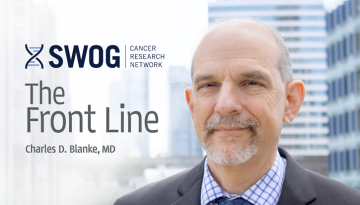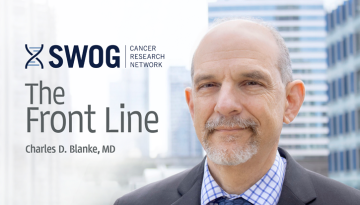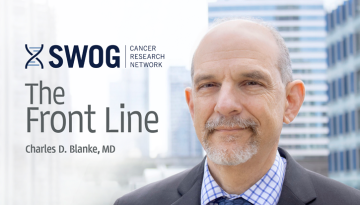COVID and SWOG Clinical Trial Accrual
In the early days of the pandemic, we expected that the harsh changes and limitations we suddenly faced would have to be endured for a matter of weeks. Soon it sunk in that it would be a matter of months – perhaps longer. We faced a number of changes and feared research might take a back seat to survival. Now we find ourselves starting to think in pandemic years, and we’ve published findings that report on year 1 of the COVID pandemic and the effect on SWOG cancer trial accrual.
The report came out of a group of SWOG researchers led by our prolific Joe Unger, PhD, in JAMA Network Open. He and others at our Statistics and Data Management Center performed an interrupted time-series analysis to compare rates of trial enrollment from March 2020 through February 2021 to our expectations for what enrollment in a pandemic-free world would have been, based on data from our last four years of trial enrollment.
The team found that overall enrollment to SWOG treatment trials for that one year span of time was about 91 percent of the enrollment we would have expected to see had the pandemic not struck. In short, treatment trial enrollment – while it showed marked dips and rises over the course of the year – overall fell only slightly.
The picture was somewhat less heartening for enrollment to our cancer control and prevention trials, which fell to about 54 percent of expected numbers. The authors conjecture that the markedly greater drop here may have been the result of sites prioritizing suddenly scarce resources to trials that most urgently related to patient care.
What I’d really like to explore, though, are the likely reasons the drop in treatment trials was only modest. First and foremost these enrollment numbers in the face of a 100-year pandemic are a testament to the incredible fortitude and commitment of our members. But they were also made possible by the set of special guidelines rolled out by the NCI and FDA that allowed for greater flexibility in how we conduct trials.
Most of you are familiar with these changes, which I have commented on before. They include
- remote consenting,
- delivery of some investigational drugs to patients’ homes,
- virtual clinic visits,
- remote trial auditing, and
- expanded use of local providers and testing facilities.
As I said in an interview with Nature last month, I truly believe these changes made all the difference for enrollment to SWOG treatment trials, and we -- and our patients! -- are eager to keep many of these in place.
Now that many states and organizations have lifted restrictions and at least some routines are returning to a recognizable version of normal, we need to make the changes summarized above a permanent part of our standard operating procedures, where possible, because they still make for more efficient and more patient-centered studies.
As a group that includes leaders from the AACR, NCI, and FDA argued last week in an opinion piece published in Cancer Discovery, the flexibilities adopted in the early weeks of the pandemic helped accelerate a movement away from the traditional model of clinical trials centered on the medical center – with all consenting, therapy, and assessment done at the core clinic – and toward a model that has the patient as the center and moves more trial functions to the patient’s home or nearest local provider.
Incorporating many of these changes long-term into how cancer trials are conducted could not only mean studies require fewer resources but could also broaden access to trials by making participation easier for patients in rural and underserved areas.
Simply put, the changes have made, and continue to make, a difference – for our trials and for our patients!
Other Recent Stories



